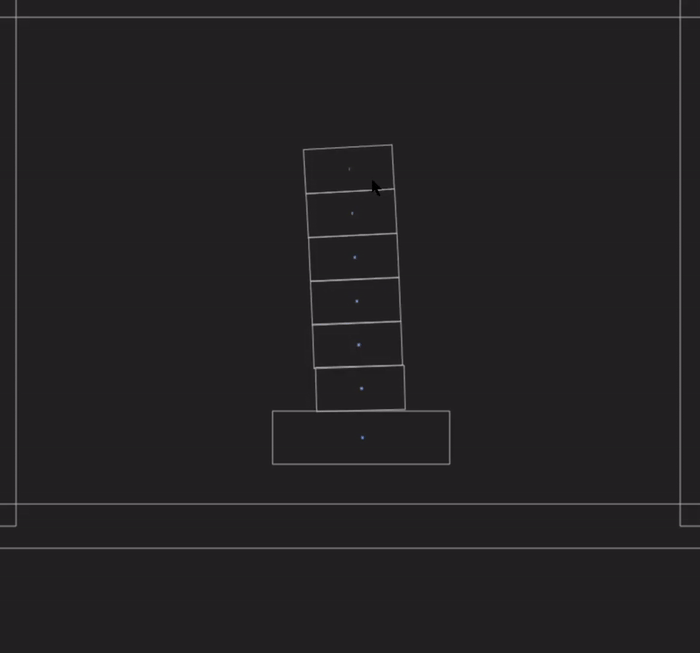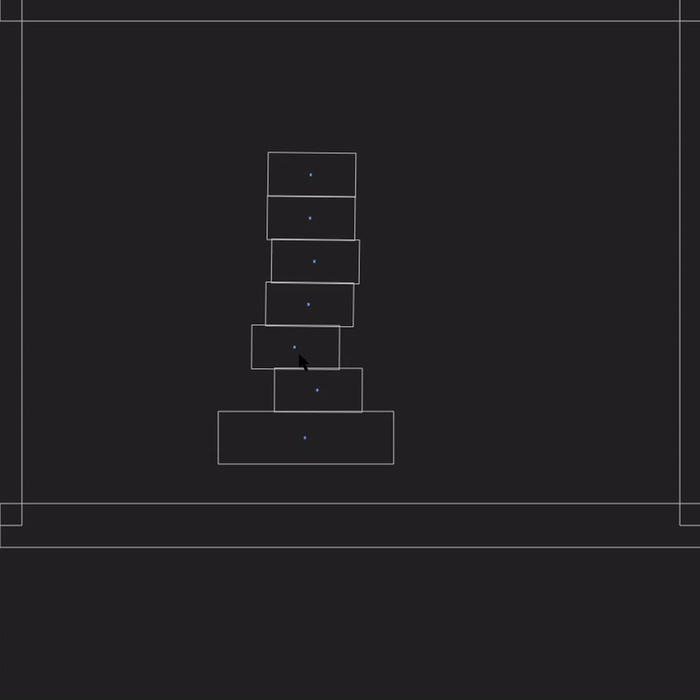Prevent Force-dragging Bodies Through Other Bodies With Matterjs
Solution 1:
I think that the best answer here would be a significant overhaul to the Matter.Resolver module to implement predictive avoidance of physical conflicts between any bodies. Anything short of that is guaranteed to fail under certain circumstances. That being said here are two "solutions" which, in reality, are just partial solutions. They are outlined below.
Solution 1 (Update)
This solution has several advantages:
- It is more concise than Solution 2
- It creates a smaller computational footprint than Solution 2
- The drag behavior is not interrupted the way it is in Solution 2
- It can be non-destructively combined with Solution 2
The idea behind this approach is to resolve the paradox of what happens "when an unstoppable force meets an immovable object" by rendering the force stoppable. This is enabled by the Matter.EventbeforeUpdate, which allows the absolute velocity and impulse (or rather positionImpulse, which isn't really physical impulse) in each direction to be constrained to within user-defined bounds.
window.addEventListener('load', function() {
var canvas = document.getElementById('world')
var mouseNull = document.getElementById('mouseNull')
var engine = Matter.Engine.create();
var world = engine.world;
var render = Matter.Render.create({ element: document.body, canvas: canvas,
engine: engine, options: { width: 800, height: 800,
background: 'transparent',showVelocity: true }});
var body = Matter.Bodies.rectangle(400, 500, 200, 60, { isStatic: true}),
size = 50, counter = -1;
var stack = Matter.Composites.stack(350, 470 - 6 * size, 1, 6,
0, 0, function(x, y) {
returnMatter.Bodies.rectangle(x, y, size * 2, size, {
slop: 0, friction: 1, frictionStatic: Infinity });
});
Matter.World.add(world, [ body, stack,
Matter.Bodies.rectangle(400, 0, 800, 50, { isStatic: true }),
Matter.Bodies.rectangle(400, 600, 800, 50, { isStatic: true }),
Matter.Bodies.rectangle(800, 300, 50, 600, { isStatic: true }),
Matter.Bodies.rectangle(0, 300, 50, 600, { isStatic: true })
]);
Matter.Events.on(engine, 'beforeUpdate', function(event) {
counter += 0.014;
if (counter < 0) { return; }
var px = 400 + 100 * Math.sin(counter);
Matter.Body.setVelocity(body, { x: px - body.position.x, y: 0 });
Matter.Body.setPosition(body, { x: px, y: body.position.y });
if (dragBody != null) {
if (dragBody.velocity.x > 25.0) {
Matter.Body.setVelocity(dragBody, {x: 25, y: dragBody.velocity.y });
}
if (dragBody.velocity.y > 25.0) {
Matter.Body.setVelocity(dragBody, {x: dragBody.velocity.x, y: 25 });
}
if (dragBody.positionImpulse.x > 25.0) {
dragBody.positionImpulse.x = 25.0;
}
if (dragBody.positionImpulse.y > 25.0) {
dragBody.positionImpulse.y = 25.0;
}
}
});
var mouse = Matter.Mouse.create(render.canvas),
mouseConstraint = Matter.MouseConstraint.create(engine, { mouse: mouse,
constraint: { stiffness: 0.1, render: { visible: false }}});
var dragBody = nullMatter.Events.on(mouseConstraint, 'startdrag', function(event) {
dragBody = event.body;
});
Matter.World.add(world, mouseConstraint);
render.mouse = mouse;
Matter.Engine.run(engine);
Matter.Render.run(render);
});<canvasid="world"></canvas><scriptsrc="https://cdnjs.cloudflare.com/ajax/libs/matter-js/0.10.0/matter.js"></script>In the example I am restricting the velocity and positionImpulse in x and y to a maximum magnitude of 25.0. The result is shown below
As you can see, it is possible to be quite violent in dragging the bodies and they will not pass through one another. This is what sets this approach apart from others: most other potential solutions fail when the user is sufficiently violent with their dragging.
The only shortcoming I have encountered with this method is that it is possible to use a non-static body to hit another non-static body hard enough to give it sufficient velocity to the point where the Resolver module will fail to detect the collision and allow the second body to pass through other bodies. (In the static friction example the required velocity is around 50.0, I've only managed to do this successfully one time, and consequently I do not have an animation depicting it).
Solution 2
This is an additional solution, fair warning though: it is not straightforward.
In broad terms the way this works is to check if the body being dragged, dragBody, has collided with a static body and if the mouse has since moved too far without dragBody following. If it detects that the separation between the mouse and dragBody has become too large it removes the Matter.jsmouse.mousemove event listener from mouse.element and replaces it with a different mousemove function, mousemove(). This function checks if the mouse has returned to within a given proximity of the center of the body. Unfortunately I couldn't get the built-in Matter.Mouse._getRelativeMousePosition() method to work properly so I had to include it directly (someone more knowledgeable than me in Javascript will have to figure that one out). Finally, if a mouseup event is detected it switches back to the normal mousemove listener.
window.addEventListener('load', function() {
var canvas = document.getElementById('world')
var mouseNull = document.getElementById('mouseNull')
var engine = Matter.Engine.create();
var world = engine.world;
var render = Matter.Render.create({ element: document.body, canvas: canvas,
engine: engine, options: { width: 800, height: 800,
background: 'transparent',showVelocity: true }});
var body = Matter.Bodies.rectangle(400, 500, 200, 60, { isStatic: true}),
size = 50, counter = -1;
var stack = Matter.Composites.stack(350, 470 - 6 * size, 1, 6,
0, 0, function(x, y) {
returnMatter.Bodies.rectangle(x, y, size * 2, size, {
slop: 0.5, friction: 1, frictionStatic: Infinity });
});
Matter.World.add(world, [ body, stack,
Matter.Bodies.rectangle(400, 0, 800, 50, { isStatic: true }),
Matter.Bodies.rectangle(400, 600, 800, 50, { isStatic: true }),
Matter.Bodies.rectangle(800, 300, 50, 600, { isStatic: true }),
Matter.Bodies.rectangle(0, 300, 50, 600, { isStatic: true })
]);
Matter.Events.on(engine, 'beforeUpdate', function(event) {
counter += 0.014;
if (counter < 0) { return; }
var px = 400 + 100 * Math.sin(counter);
Matter.Body.setVelocity(body, { x: px - body.position.x, y: 0 });
Matter.Body.setPosition(body, { x: px, y: body.position.y });
});
var mouse = Matter.Mouse.create(render.canvas),
mouseConstraint = Matter.MouseConstraint.create(engine, { mouse: mouse,
constraint: { stiffness: 0.2, render: { visible: false }}});
var dragBody, overshoot = 0.0, threshold = 50.0, loc, dloc, offset,
bodies = Matter.Composite.allBodies(world), moveOn = true;
getMousePosition = function(event) {
var element = mouse.element, pixelRatio = mouse.pixelRatio,
elementBounds = element.getBoundingClientRect(),
rootNode = (document.documentElement || document.body.parentNode ||
document.body),
scrollX = (window.pageXOffset !== undefined) ? window.pageXOffset :
rootNode.scrollLeft,
scrollY = (window.pageYOffset !== undefined) ? window.pageYOffset :
rootNode.scrollTop,
touches = event.changedTouches, x, y;
if (touches) {
x = touches[0].pageX - elementBounds.left - scrollX;
y = touches[0].pageY - elementBounds.top - scrollY;
} else {
x = event.pageX - elementBounds.left - scrollX;
y = event.pageY - elementBounds.top - scrollY;
}
return {
x: x / (element.clientWidth / (element.width || element.clientWidth) *
pixelRatio) * mouse.scale.x + mouse.offset.x,
y: y / (element.clientHeight / (element.height || element.clientHeight) *
pixelRatio) * mouse.scale.y + mouse.offset.y
};
};
mousemove = function() {
loc = getMousePosition(event);
dloc = dragBody.position;
overshoot = ((loc.x - dloc.x)**2 + (loc.y - dloc.y)**2)**0.5 - offset;
if (overshoot < threshold) {
mouse.element.removeEventListener("mousemove", mousemove);
mouse.element.addEventListener("mousemove", mouse.mousemove);
moveOn = true;
}
}
Matter.Events.on(mouseConstraint, 'startdrag', function(event) {
dragBody = event.body;
loc = mouse.position;
dloc = dragBody.position;
offset = ((loc.x - dloc.x)**2 + (loc.y - dloc.y)**2)**0.5;
Matter.Events.on(mouseConstraint, 'mousemove', function(event) {
loc = mouse.position;
dloc = dragBody.position;
for (var i = 0; i < bodies.length; i++) {
overshoot = ((loc.x - dloc.x)**2 + (loc.y - dloc.y)**2)**0.5 - offset;
if (bodies[i] != dragBody &&
Matter.SAT.collides(bodies[i], dragBody).collided == true) {
if (overshoot > threshold) {
if (moveOn == true) {
mouse.element.removeEventListener("mousemove", mouse.mousemove);
mouse.element.addEventListener("mousemove", mousemove);
moveOn = false;
}
}
}
}
});
});
Matter.Events.on(mouseConstraint, 'mouseup', function(event) {
if (moveOn == false){
mouse.element.removeEventListener("mousemove", mousemove);
mouse.element.addEventListener("mousemove", mouse.mousemove);
moveOn = true;
}
});
Matter.Events.on(mouseConstraint, 'enddrag', function(event) {
overshoot = 0.0;
Matter.Events.off(mouseConstraint, 'mousemove');
});
Matter.World.add(world, mouseConstraint);
render.mouse = mouse;
Matter.Engine.run(engine);
Matter.Render.run(render);
});<canvasid="world"></canvas><scriptsrc="https://cdnjs.cloudflare.com/ajax/libs/matter-js/0.10.0/matter.js"></script>After applying the event listener switching scheme the bodies now behave more like this
I have tested this fairly thoroughly, but I can't guarantee it will work in every case. It also bears noting that the mouseup event is not detected unless the mouse is within the canvas when it occurs - but this is true for any Matter.js mouseup detection so I didn't try to fix that.
If the velocity is sufficiently large, Resolver will fail to detect any collision, and since it lacks predictive prevention of this flavor of physical conflict, will allow the body to pass through, as shown here.
This can be resolved by combining with Solution 1.
One last note here, it is possible to apply this to only certain interactions (e.g. those between a static and a non-static body). Doing so is accomplished by changing
if (bodies[i] != dragBody && Matter.SAT.collides(bodies[i], dragBody).collided == true) {
//...
}
to (for e.g. static bodies)
if (bodies[i].isStatic == true && bodies[i] != dragBody &&
Matter.SAT.collides(bodies[i], dragBody).collided == true) {
//...
}
Failed solutions
In case any future users come across this question and find both solutions insufficient for their use case, here are some of the solutions I attempted which did not work. A guide of sorts for what not to do.
- Calling
mouse.mouseupdirectly: object deleted immediately. - Calling
mouse.mouseupviaEvent.trigger(mouseConstraint, 'mouseup', {mouse: mouse}): overridden byEngine.update, behavior unchanged. - Making the dragged object temporarily static: object deleted on returning to non-static (whether via
Matter.Body.setStatic(body, false)orbody.isStatic = false). - Setting the force to
(0,0)viasetForcewhen approaching conflict: object can still pass through, would need to be implemented inResolverto actually work. - Changing
mouse.elementto a different canvas viasetElement()or by mutatingmouse.elementdirectly: object deleted immediately. - Reverting object to last 'valid' position: still allows pass through,
- Change behavior via
collisionStart: inconsistent collision detection still permits pass through with this method
Solution 2:
I would have managed the feature in another way:
- No "drag" (so no continuos align of dragpoint with offset Vs dragged object)
- On mouseDown the mouse pointer position give an oriented velocity vector for object to follow
- On mouseUp reset your velocity vector
- Let the matter simulation do the rest
Solution 3:
To control collision when dragged you need to utilize collision filter and events.
Create bodies with default collision filter mask0x0001. Add catch startdrag and enddrag events and set different body collision filter category to temporarily avoid collisions.
Matter.Events.on(mouseConstraint, 'startdrag', function(event) {
event.body.collisionFilter.category = 0x0008; // move body to new category to avoid collision
});
Matter.Events.on(mouseConstraint, 'enddrag', function(event) {
event.body.collisionFilter.category = 0x0001; // return body to default category to activate collision
});
window.addEventListener('load', function () {
//Fetch our canvasvar canvas = document.getElementById('world');
//Setup Matter JSvar engine = Matter.Engine.create();
var world = engine.world;
var render = Matter.Render.create({
canvas: canvas,
engine: engine,
options: {
width: 800,
height: 800,
background: 'transparent',
wireframes: false,
showAngleIndicator: false
}
});
//Add a ballconst size = 50;
const stack = Matter.Composites.stack(350, 470 - 6 * size, 1, 6, 0, 0, (x, y) => {
returnMatter.Bodies.rectangle(x, y, size * 2, size, {
collisionFilter: {
mask: 0x0001,
},
slop: 0.5,
friction: 1,
frictionStatic: Infinity,
});
});
Matter.World.add(engine.world, stack);
//Add a floorvar floor = Matter.Bodies.rectangle(250, 520, 500, 40, {
isStatic: true, //An immovable objectrender: {
visible: false
}
});
Matter.World.add(world, floor);
//Make interactivevar mouseConstraint = Matter.MouseConstraint.create(engine, { //Create Constraintelement: canvas,
constraint: {
render: {
visible: false
},
stiffness: 0.8
}
});
Matter.World.add(world, mouseConstraint);
// add events to listen dragMatter.Events.on(mouseConstraint, 'startdrag', function (event) {
event.body.collisionFilter.category = 0x0008; // move body to new category to avoid collision
});
Matter.Events.on(mouseConstraint, 'enddrag', function (event) {
event.body.collisionFilter.category = 0x0001; // return body to default category to activate collision
});
//Start the engineMatter.Engine.run(engine);
Matter.Render.run(render);
});<canvasid="world"></canvas><scriptsrc="https://cdnjs.cloudflare.com/ajax/libs/matter-js/0.10.0/matter.min.js"></script>Solution 4:
This seems to be related to issue 672 on their GitHub page which seems to suggest that this occurs due to a lack of Continuous Collision Detection (CCD).
An attempt to remedy this has been made and the code for it can be found here but the issue is still open so it looks like you might need to edit the engine to build CCD into it yourself.



Post a Comment for "Prevent Force-dragging Bodies Through Other Bodies With Matterjs"